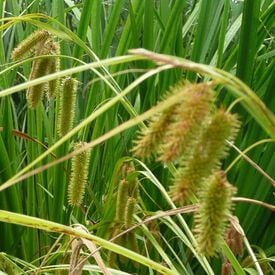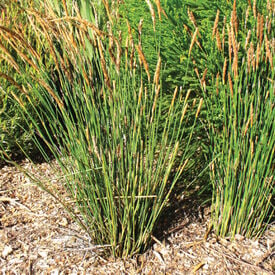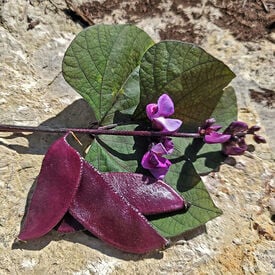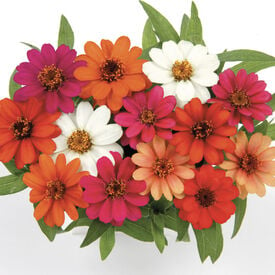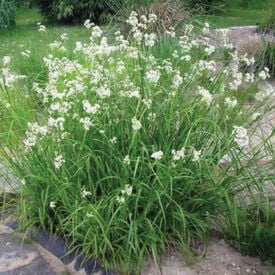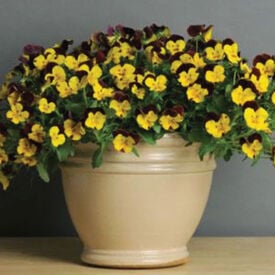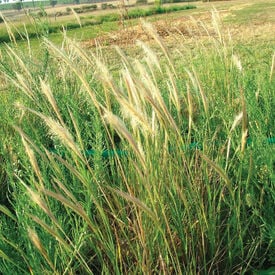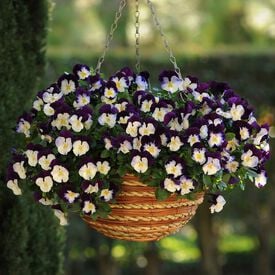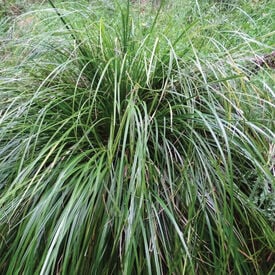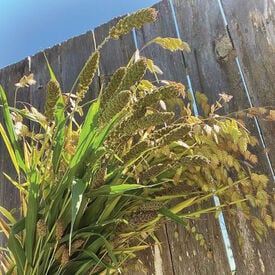Polar Star Hollyhock (Alcea rosea 'Polarstar') is an elegant, tall perennial known for its large, pure white, single blooms that bring a luminous, refreshing presence to garden landscapes. Part of the "Spotlight Series," this variety combines the traditional charm of hollyhocks with improved vigor and disease resistance, especially against rust. Growing up to 5 to 6 feet tall, Polar Star makes a stunning backdrop in borders or cottage gardens, thriving in full sun and well-drained soil. Its striking white flowers not only provide a beautiful contrast to darker blooms but also attract pollinators like bees and butterflies, enhancing both visual appeal and garden health.
Mars Magic Hollyhock (Alcea rosea 'Mars Magic') is a vibrant, tall perennial prized for its rich, bright red, saucer-shaped flowers that bloom on sturdy, upright spikes throughout the summer. A member of the "Spotlight Series," this variety is known for its strong, single blooms and improved resistance to rust, making it a more resilient choice for cottage gardens and mixed borders. Reaching heights of 5 to 6 feet, Mars Magic adds bold vertical interest and color, thriving in full sun and well-drained soil. Its nectar-rich flowers attract pollinators like bees and butterflies, making it as beneficial as it is beautiful.
Purple Rain Hollyhock (Alcea rosea 'Purpurkerze', often marketed as 'Purple Rain') is a stunning perennial hollyhock variety known for its tall, stately spikes covered in rich, deep purple single blooms. Reaching heights of 5 to 6 feet, it brings bold vertical interest and dramatic color to cottage gardens, back borders, and sunny fences. This variety thrives in full sun and well-drained soil, with a relatively strong resistance to rust compared to older hollyhock types. Blooming from mid to late summer, Purple Rain attracts bees, butterflies, and other pollinators, making it both a visually striking and ecologically valuable addition to the garden.
Blacknight Hollyhock (Alcea rosea 'Blacknight') is a striking, tall-growing perennial known for its deep, almost black, maroon-purple blooms that add dramatic contrast to garden borders and cottage-style landscapes. Part of the renowned "Spotlight Series," this hollyhock variety typically reaches heights of 5 to 6 feet and produces single, saucer-shaped flowers on sturdy, upright stems from mid to late summer. It thrives in full sun and well-drained soil, attracting pollinators like bees and butterflies while also being relatively deer-resistant. Ideal for background planting or along fences and walls, Blacknight Hollyhock combines old-fashioned charm with a bold, modern color.
Carex comosa is a large tufted wetland sedge. The narrow leaves are lime green and shiny. In late spring triangular culms rise above the foliage to 5’ bearing large chartreuse bottlebrush shaped spikes. Attractive warm brown seed spikes follow. This bold sedge flourishes in sun or part sun in damp or wet sites. Plants prosper in difficult wet mucky soils or even in shallow water.
QIS Red Gomphrena ia highly productive accent flower that is excellent for fresh bouquets or dried arrangements. Produces 1-2" blooms in vibrant red color. The QIS (Quality in Seed) Series is a florist favorite for its consistent production in quality, length, and uniformity. Also known as globe amaranth and common globe amaranth.
Sunshine Hollyhock (Alcea rosea 'Sunshine') is a cheerful and radiant perennial known for its bright, buttery yellow single blooms that bring warmth and light to garden spaces. As part of the "Spotlight Series," it features sturdy, upright stems that can grow 5 to 6 feet tall, making it an excellent choice for the back of borders, along fences, or in cottage-style gardens. Blooming from mid to late summer, Sunshine Hollyhock thrives in full sun and well-drained soil, and it offers improved resistance to rust compared to older varieties. Its vibrant flowers attract bees, butterflies, and other pollinators, adding both color and ecological value to the landscape.
A large reed-like plant with long dark green stems that produce male and female flowers. Flowers are dark brown and can sometimes appear almost black. Individual flowers are almost microscopic and can number anywhere from 50 to over 500 flowers per stem.
Ruby Moon Hyacinth Bean, also known as Lablab purpureus or simply Hyacinth Bean, is a unique and versatile legume known for its vibrant appearance and culinary potential. This heirloom variety is named for its striking ruby-red pods and dark green foliage, making it an attractive addition to both ornamental and edible gardens. Ruby Moon Hyacinth Beans are typically grown as annuals, but in tropical regions, they can be perennial. In terms of taste, the young pods and seeds of Ruby Moon Hyacinth Bean are edible and have a mild, nutty flavor similar to green beans. They can be consumed both raw and cooked. However, it's important to note that mature seeds contain toxic compounds and should not be eaten without proper processing. Ruby Moon Hyacinth Beans have a rich history, with their cultivation dating back centuries, primarily in Asia and Africa. They are valued not only for their culinary uses but also for their ability to fix nitrogen in the soil, enhancing soil fertility. This plant is categorized as a warm-season annual and typically matures in about 60-90 days, depending on growing conditions. The size of the Ruby Moon Hyacinth Bean plant can vary, but it generally reaches a height of 6-10 feet, making it suitable for trellises or fences. When it comes to yield, you can expect approximately 10-15 pounds of pods per plant or around 800-1,200 pounds per acre under ideal conditions. These beans thrive in full sun and well-drained soil, and they require a warm climate to grow successfully. Adequate moisture and support for climbing are essential for a bountiful harvest. With proper care, Ruby Moon Hyacinth Beans can be a delightful addition to your garden, offering both visual appeal and a tasty, nutritious addition to your plate.
Radiant Rose Hollyhock (Alcea rosea 'Radiant Rose') is a vibrant and eye-catching perennial celebrated for its large, single, rose-pink blooms that brighten garden borders with a cheerful pop of color. Part of the refined "Spotlight Series," this variety features strong, upright stems that can reach 5 to 6 feet tall, making it ideal for adding vertical interest to cottage-style or traditional garden settings. Blooming from mid to late summer, Radiant Rose performs best in full sun and well-drained soil, with improved resistance to rust and other common hollyhock diseases. Its nectar-rich flowers attract butterflies and bees, enhancing both beauty and biodiversity in the landscape.
This 5 Color Profusion Mix is a beautiful zinnia blend with whites, peach, oranges, reds and dark-pinks. A popular variety for greenhouse growers, containers and in the garden. Excellent disease resistance and uniformity. Also does very well in extreme heat and drought tolerant. Compact growth and excellent performance allow it to grow in all climates.
Snowy Wood Rush is a slowly spreading evergreen perennial with fairly dense clusters of shimmering white flower spikes in early and mid-summer. The plant forms a loose clump of narrow, rich, green leaves, 12" long with edges of fine hairs.
The Goldeneye F1 Sunflower is a beautiful 100% pollen-less single headed variety that can be enjoyed all throughout the season. This beauty can grow up to four feet tall and has bright sunny blooms. Its core starts out as pale green and then matures to a light brown color.
Sunshine and Wine Swirl Cool Wave is a fast growing, long lasting trailing pansy for Spring and Autumn. Very similar to Red Wine with yellow petals and maroon tips. Avg. 24,415 seeds/oz. Packet: 10 seeds.
Dichelachne crinita, commonly known as the longhair plume grass, is a type of grass found in Australia, New Zealand and islands off the Pacific Ocean. It is often seen on sandy soils near the sea as well as woodlands. The flowering panicles are open and feathery at maturity.
Violet Wing Cool Wave is a fast growing, long lasting trailing pansy for Spring and Autumn. Yellow centers, with white petals that have dark violet tips. Avg. 24,415 seeds/oz. Packet: 10 seeds.
A common grass in wet or moist habitats in temperate to cold temperatures. The stems of sedges are solidly filled with pith, and do not have nodes. They are triangular in cross section. The leaves are arranged in three rows, with sheaths usually fused around the stem. Leaf blades of sedges are usually grass-like; with evergreen or semi-evergreen foliage.
Produces strong bronze-colored plumes that are beautiful in floral arrangements. 3–6" pendulous heads.




